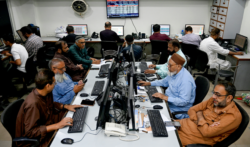Capital suggestion: Shift the focus

October 15, 2023
Much of the government’s attention in Pakistan has been fixated on the rupee-dollar exchange rate. While this rate undeniably holds significance in the country’s economic landscape, it should not be the sole focus when addressing Pakistan’s myriad economic and financial challenges. Instead, a more comprehensive approach is needed – one that looks beyond exchange rates and takes into account various critical indicators, with a particular emphasis on the budget deficit.
The rupee-dollar exchange rate has garnered excessive attention. This fixation neglects the broader economic picture. Pakistan’s economic health is influenced by a complex interplay of indicators such as inflation management, unemployment, national debt, trade balance and GDP growth.
One of the key indicators that deserves more attention than any other is the budget deficit. Budget deficit, simply put, is the difference between government revenues and expenditures. When expenditures exceed revenues, it leads to a budget deficit. This is a crucial metric to monitor because it has far-reaching implications for the overall economy.
A persistent and elevated budget deficit compels the government to engage in excessive money printing. This extensive money supply expansion has resulted in numerous unfavorable consequences, such as inflation and the devaluation of the Pakistani rupee. The consistently high budget deficit has also led to increased borrowing and a mounting national debt. The budget deficit is indeed the underlying cause of a hundred economic ills.
A direct link exists between the budget deficit and the devaluation of the Pakistani rupee. The government’s budget deficit of Rs8200 billion signifies that its expenditures surpass its revenue collection by the same amount. To cover this deficit, the government has resorted to massive borrowing, primarily through bond issuance, amounting to trillions.
This substantial increase in the money supply has infused a significant amount of currency into circulation, consequently triggering pronounced inflationary pressures. An excess of currency in circulation diminishes the value of each unit of currency since there is a surplus of currency in relation to available goods and services within the economy. Consequently, the purchasing power of the Pakistani rupee has eroded, resulting in higher prices.
Administrative actions, such as efforts to combat currency smuggling and increased scrutiny of exchange companies, have yielded certain positive outcomes. However, it is crucial to acknowledge that administrative measures have inherent limitations and are not a sustainable solution. Administrative actions cannot replace the need for a comprehensive policy approach. The question we must address is whether we have a viable policy strategy in place to effectively reduce the budget deficit.
In conclusion, it is high time Pakistan shifted its focus from the fixation on the rupee-dollar exchange rate and adopted a more holistic approach to its economic challenges. The link between the budget deficit and the devaluation of the rupee is undeniable. Excessive borrowing and money supply expansion, driven by the deficit, has eroded the rupee’s purchasing power. This is the cycle that must be broken.
While administrative measures have yielded some positive results, they are not a panacea. We need a robust and sustainable policy strategy to tackle the budget deficit head-on. Only by doing so can we pave the way for a more stable, resilient, and prosperous economic future for Pakistan. It’s time to shift our focus and take decisive action for the well-being of our nation.





